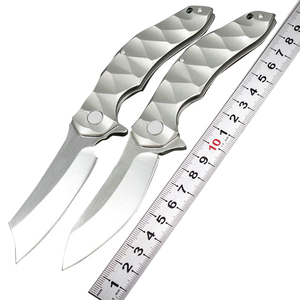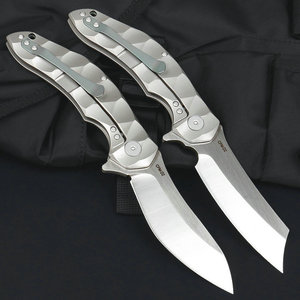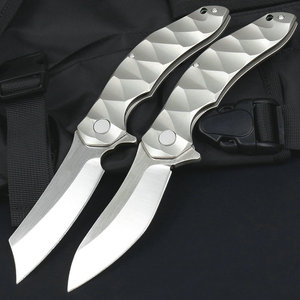
All categories
Featured selections
Trade Assurance
Buyer Central
Help Center
Get the app
Become a supplier

(4631 products available)





















A knife blade making machine comes in different kinds, each with a unique feature. Here are some of them:
Universal Grinder Machine:
The universal grinder is a popular knife-making machine that many users prefer. Aside from being popular, it is also powerful, efficient, and multifunctional. The machine performs various tasks. It can grind, sharpen, drill, and hollow the knife blades. Knife-making workshops use it on metal and wooden pieces. Like every other grinder machine, the universal one has grinding wheels of different sizes. The wheel a user chooses will depend on the specific tasks and requirements.
Belt Grinder Machine:
This machine is more specialized than the universal grinder. The belt grinder performs one main task - sharpening knife blades. It does this by using a grinding belt and an adjustable workspace. The grinding belts come in a variety, and each will produce a distinct finish. The machine is good for achieving fine details and precision.
Metal Cutting Band Saw Machine:
In metal knife blade making, the machine that prepares metal blades is known as the band saw. Its job is to cut the metal to the desired shapes and sizes for further processing. It does this by using a long, continuous band of metal. This band has teeth along its length. The saw machines come with different blade sizes and specifications for distinct metal cutting applications. Using the saw machine as the first step in the knife-making process will create the rough shape before going to the refining stage.
CNC Router Machine:
In woodworking, the CNC (Computer Numerical Control) router is very popular. The machine has a high level of automation, which means it carves and cuts wood-based materials without requiring manual intervention. The computer control system directs the knife blade-making router to follow precise patterns and paths, producing highly accurate and consistent results. Using the CNC machine helps to streamline the workflow. It also enhances efficiency and makes complex designs easier to create.
Materials
A knife-making machine works with various kinds of steel, including carbon steel, stainless steel, and tool steel. Each kind has unique characteristics, like how long it will last and how much it can stand up to heat. For instance, carbon steel is well-known for producing sharp knife blades because it gets super sharp, but it's not as resistant to rust as stainless steel. Stainless steel survives rust, which makes it a more popular choice for kitchen knives, while tool steel excels in durability and edge retention. Choosing the right material is important because it affects the knife's function and the customers' satisfaction.
Type of machine
Using a CNC knife blade machine increases production speed and guarantees consistent results. CNC machines accept digital designs and carve out knife blades automatically. Some machines use laser cutting for even more precise cuts. On the other hand, electrochemical knife machine blades also provide accurate shaping of knife blades using chemical reactions and electricity. All of these different kinds of machines let business buyers make more knife blades in a shorter time and ensure that each one is exactly the same.
Modular parts
Modular components of a knife-making machine offer flexibility and customization. Interchangeable parts allow for easy scalability and adaptation to different blade shapes and sizes. Modular systems streamline production processes, enhancing efficiency and responsiveness to market demands. Moreover, they enable rapid prototyping and cost-effective manufacturing solutions. Businesses can effortlessly switch out modules to accommodate changing production requirements. The knife-making machine's modular design empowers companies to swiftly introduce new products while maintaining high-quality standards. This adaptability ensures that businesses stay competitive in dynamic industries, meeting customer expectations with agility and precision.
Automated lubrication system
An automated lubrication system in a knife-making machine enhances maintenance and ensures optimal performance. This advanced mechanism provides a consistent and precise supply of lubricants to vital components. By frequently supplying lubricant, it reduces friction, extends tool life, and guarantees smooth operation. The automated system enhances machine uptime by reducing manual intervention and minimizing downtime associated with frequent lubricant application. Furthermore, it enhances product quality by maintaining the optimal condition of cutting tools. With controlled lubrication, the knife-making machine achieves excellent precision and longevity, meeting the rigorous demands of professional-grade blade production.
Regular care of the machines that make knife blades helps them last longer and work better. Daily cleaning is important to stop dirt and bits from building up. Using the right cleaning supplies is key to keeping the machines in good shape. Buying blade-making machines with easy-to-replace parts saves repair time. It's also smart to create a maintenance schedule based on how often and hard the machines are used to do the best upkeep.
Knife making machines are used to manufacture knife blades for various applications. The following are their most common use scenarios.
Industrial knife production
Factories and workshops use knife blade making machines to produce large volumes of knife blades to be assembled into final products. These machines provide an efficient means of creating knife blades in bulk to meet market demand. They typically have a high capacity and can operate for extended periods without needing downtime for blade changes or adjustments.
Food processing
Food processing companies often use knife blade making machines to create blades for food-cutting knives. After which, they can customize the blades to suit specific food items, such as meat, vegetables, and bakery products. Using machines eliminates the inconsistencies and irregularities that manual production typically comes with, ensuring every knife will cut as desired.
Metalworking and manufacturing
Manufacturing industries use knife-making machines to produce blades for industrial knives used in various manufacturing processes. With machines, manufacturers can easily create tough steel knives that will remain effective even under harsh working conditions. Hence, manufacturing facilities enjoy seamless operations all day, every day.
Custom knife production
Knife-making machines are used to manufacture custom knife blades for specific customers' requirements. With just a few adjustments and reconfigurations, the machines can produce blades of different shapes, sizes, and materials. Companies that offer customization services to their clients can rely on the machines for their flexibility and versatility. There are no limitations when it comes to creating unique, personalized blades.
Repair and replacement
Service centers and repair shops can blade-making machines to manufacture replacement blades for damaged or worn-out knives. Instead of sourcing blades from external suppliers, these centers can make their own and offer faster service to their customers. Knife-making machines give such repair and service centers independence and control.
Required Production Capacity:
A machine that aligns with the needs of the business should be selected. If mass production is intended, consider machines with automated features. For small-scale production, a machine with manual controls may suffice and save costs.
Knife Blade Types:
Determine the machine needed based on the knife blades produced. Specific machines are suitable for distinct types of blades, such as straight, serrated, or pointed knife blade making machines.
Material Compatibility:
The chosen blade-making machine should work seamlessly with the materials used for knife blades. Whether stainless steel, carbon steel, or another alloy, ensure the machine can handle the chosen material with precision and reliability.
Machine Size and Space Requirements:
Consider the dimensions of the machine and the space it occupies. Ensure enough production space to accommodate the new equipment alongside existing machinery and workstations.
Energy Consumption and Efficiency:
Evaluate the machine's energy usage and its efficiency in blade production. Choose equipment that balances performance with economical energy consumption to manage production costs effectively.
Maintenance and Support:
Consider the maintenance needs of the chosen machine and the availability of support services. Research the machine's maintenance requirements and determine the proximity of support providers to ensure timely assistance when needed.
Budget and Investment:
Finally, consider the budget constraints and the amount available for investing in a new blade-making machine. Weigh the machine's features, capacity, and efficiency against its cost to make an investment that aligns with financial goals and production needs.
Q1: What kind of blades does the knife-making machine make?
A1: The knife-making blades machine makes blades for different kinds of knives, such as:
Q2: How long does it take for a professional to make a knife with a knife-making machine?
A2: Users of the knife-making machine have reported various times depending on their expertise and the type of machine they use. With practice, it's possible to produce a basic knife in 30 minutes to an hour using a quality automatic knife-making machine.
Q3: How does a CNC knife making machine work?
A3: A CNC machine works by carving out the knife's shape from a metal piece after programming the desired knife design into the computer. The process involves a series of complex cuts and engravings until the desired result is achieved.
Q4: What material does the knife-making machine use?
A4: The knife-making machine uses various types of metals. Some of the most common include stainless steel (carbon steel), tool steel, titanium, and Damascus steel.